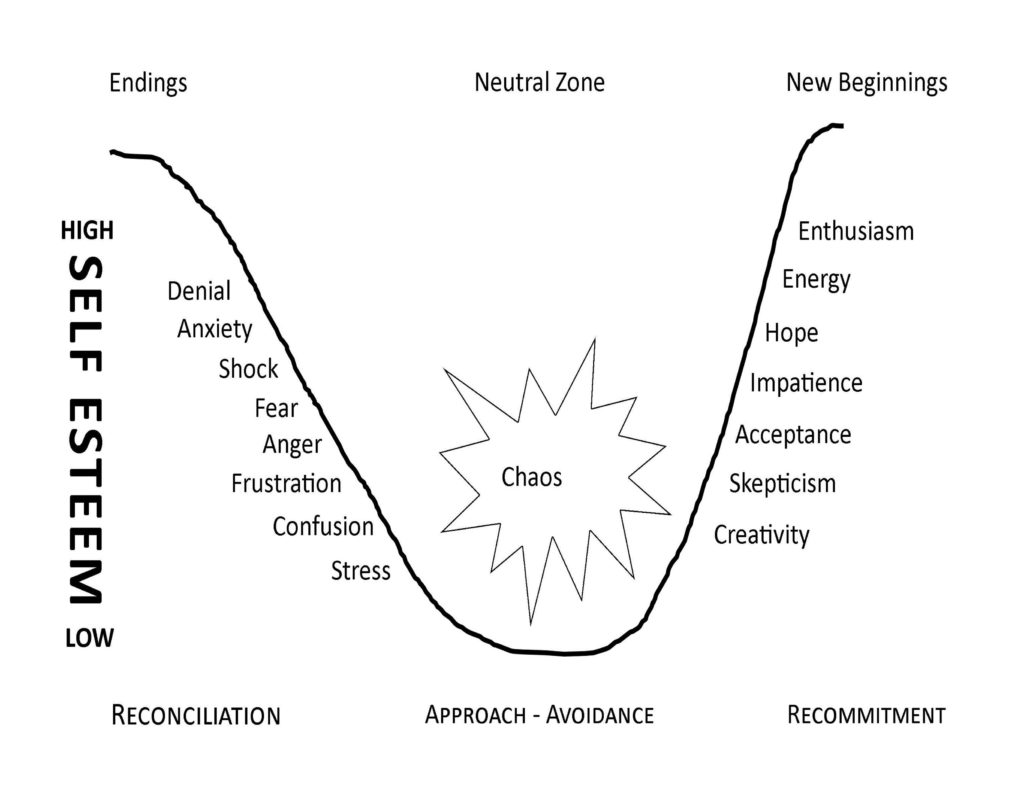Learning Objectives:
- Recognize the difference between change and transition
- Identify personal response to change and the impact on the workplace environment
- Recognize transitional levels of change recognizing where self and others are in the process
- Determine how change affects teamwork and how to respond to what you see and hear in others
- Explore the social aspects of change by observing your own reactions to change
The Jung Typology Test
Follow the link to take the Jung Typology Test. Do not dwell on the answers. Answer the questions (there are 72 of them) according to your initial reaction. After scoring, record your results from the shaded box at the top of the results page in your workbook. http://www.humanmetrics.com/cgi-win/JTypes2.asp
Seven Dynamics of Change
- People will feel awkward, ill at ease and self-conscious.
- People will think about what they have to give up.
- People will feel alone even if everyone else is going through the change.
- People can handle only so much change.
- People are at different levels of readiness for change.
- People will be concerned that they don’t have enough resources.
- If you take the pressure off, people will revert back to the old behavior

What Transition Looks Like: The Transition Phases
Endings
When things change, we leave behind “the way things were”. This happens even if change is a good one. Endings are characterized by loss, grieving, letting go, and by a feeling of identity loss. Identity is a major issue. The goal of endings is to let go. Losses may involve the following:
- Loss of Attachments – People who are largely relationship oriented are particularly vulnerable to this loss. Changes disrupt not only peer relationships but also hierarchical ones as well. When your reporting relationship changes you have to get to know the new person, what their expectations are, how you need to communicate and work with them, etc. This also happens if you work with a new group of people.
- Loss of Turf/Territory – This includes not only physical territory but also areas of responsibility. Changes that involve how things are done, who they are done through and where they will be done can lead to a loss of turf. When dealing with this loss you want to determine what interests you are protecting. Has the change invaded psychological space? Professional territory?
- Loss of Structure – This is more psychological than physical and involves the patterns of authority, policies and procedures, schedules, known deadlines etc.. It is the flow of doing business.
- Loss of Future – For some people, the present is acceptable or unacceptable based on the future it is believed to lead to. It may be the realization that promotions in the future will be far and few between or that your opportunity for promotion will now be judged by someone else or by different standards/criteria than in the past. This can be particularly painful if it involves your dreams and the realization that you may not achieve them.
- Loss of Control – When decisions that affect you are made without your input, it can give you a feeling of the situation being out of your control. Those most at risk are the people whose well being is dependent on being in control at all times and who have their days planned down to the last minute.
- Loss of Meaning – All of these losses contribute to your loss of meaning. This feeling is different for everyone. For some people, meaning is tied to the relationships that they have, for others the dream of the future, or the feeling of structure in their lives. You’ll know people are feeling this loss in particular if you hear, “I just don’t understand why we are doing this.”
Neutral Zone (Chaos)
This is an in-between time, between one world and another, between one personal identity and another, or between one way of doing things and another. Some things to expect:
- Everything feels like it is up for grabs
- What used to work doesn’t
- What may be developing isn’t here yet
- What is to be redesigned hasn’t happened yet
- Ambiguity and uncertainty
- Feeling empty
- Creativity
- Some self-questioning and self-doubt
New Beginnings
New beginnings happen only after we let go of the old way and have spent some time in chaos or the neutral zone. People ultimately become energized by new beginnings and enthusiastic about the new ways of doing things.
Sometimes it is difficult to get back on track once emotions have derailed us. We may wonder whether we are rushing ourselves or whether we really know where we are going or what we are doing. We also may wonder whether we have what it takes to get there. There may be a range of emotions:
- Creativity
- Skepticism
- Acceptance
- Impatience
- Hope
- Energy
- Enthusiasm
Content from Managing Transitions: Making the Most of Change by William Bridges, 1991.

